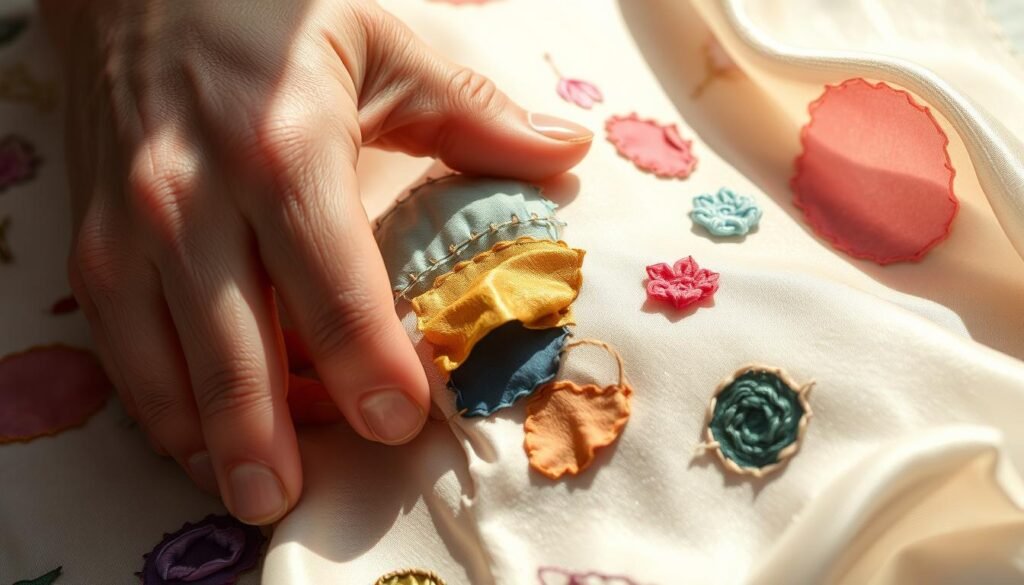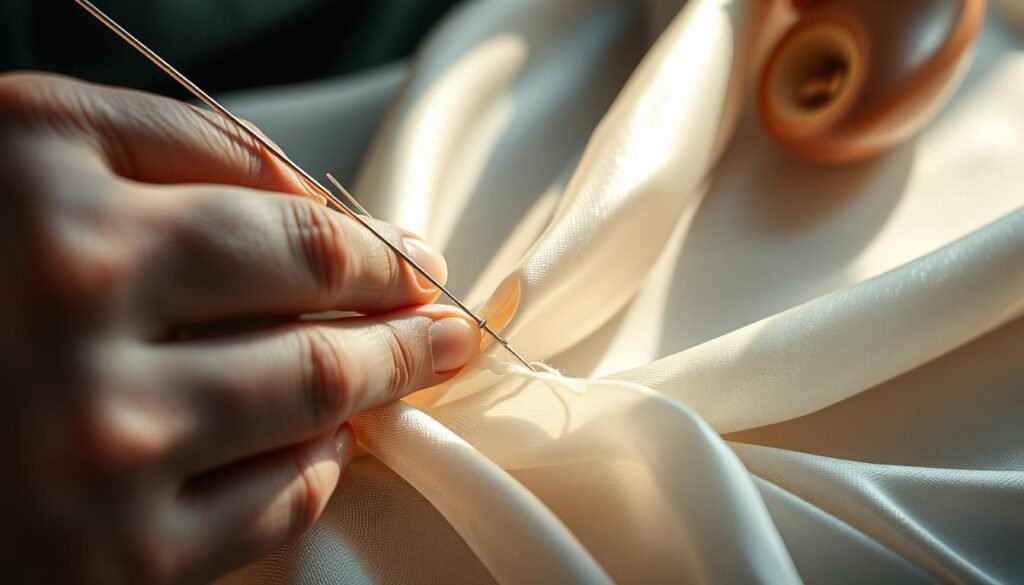Have you ever found a silk garment with a tear or discoloration? Wondered how to fix it? Silk is a luxurious fabric that can get damaged over time1. But don’t worry, this guide will show you how to fix your silk items. You’ll learn easy fixes and professional repair methods.
Key Takeaways
- Silk fabric can deteriorate over time due to exposure to chemicals and bright light, leading to tears1.
- Repairing silk garments can be achieved using techniques like fusible interfacing, which requires additional materials such as nail scissors, iron, ironing board, and press cloth1.
- Patching silk with a silk patch from the same garment is an effective repair method for tears or holes1.
- Repairing discolored silk can be done by soaking the garment in a container with water, gentle detergent, and vinegar1.
- Proper care and storage practices can help prevent damage and prolong the lifespan of silk garments2.
Introduction to Repairing Silk Fabric
Silk is a soft and luxurious natural fiber. It is known for its smooth texture and how well it drapes. Silk fabric is famous for being breathable, safe for people with allergies, and keeping a steady temperature. But, it can get damaged easily, like getting tears, snags, stains, or discoloration. Knowing how silk works and what damages it can help you fix and keep silk clothes in good shape.
The Delicate Nature of Silk
Silk fibers are strong but the fabric can be fragile. Things like chemicals, bright light, and normal wear can cause tears, discoloration, and snags. Silk’s delicate nature means it needs special care to avoid and fix these issues.
Common Causes of Silk Fabric Damage
- Chemical exposure: Harsh cleaners, sweat, and some foods can harm silk.
- Sun exposure: Too much sunlight can make silk fade and get brittle.
- Abrasion and friction: Rubbing against things can cause snags, pilling, and tears.
- Improper storage: Wrong ways of folding or storing can lead to permanent wrinkles.
Knowing about silk and common damage can help you protect and keep your silk clothes looking good3.
Fusible Interfacing Method
Fixing tears in silk fabric works well with fusible interfacing4. You put a lightweight fusible fabric on the garment’s underside. This helps to mend the tear. Silk’s delicate fibers can become weak if not handled right4.
Materials Needed
- Nail scissors
- Fusible interfacing5
- Iron
- Press cloth
Step-by-Step Instructions
- Measure the tear’s size and cut fusible interfacing a bit bigger, at least 1/2″ around5.
- Trim the silk’s torn edges to make them smooth and even.
- Put the silk fabric wrong-side-down on the ironing board.
- Put the fusible interfacing patch over the tear, making sure it covers the whole area.
- Use a hot iron and press cloth to fuse the interfacing to the silk. Steam and heat for 30 seconds to a minute5.
Fixing holes in silk scarves with fusible interfacing is a top choice4. You’ll need fusible interfacing, nail scissors, an iron, and a press cloth4. Just follow these steps to mend silk fabric tears with fusible interfacing.
Patching with Silk Fabric
If you have the same silk fabric as your damaged garment, you can make a patch that looks almost new. Silk fabric patching is great for repairing silk with same fabric. It lets you blend the new material with the old one well6. This is super useful for fixing tears or snags, making them almost gone.
Start by cutting a patch a bit bigger than the damaged spot. Make sure the patch edges are clean and smooth7. Then, use a needle and silk thread that matches the fabric. Stitch the patch on carefully, so it doesn’t pucker the fabric7. This sewing silk patch method needs a steady hand and some basic sewing skills. But, it can look really good.
For a great silk fabric patch, use silk from the garment you’re fixing, like from the inside hem or a hidden pocket7. This makes sure the repair matches the color and texture perfectly. With practice, you can get really good at silk fabric patching and fix your silk clothes.

This method can fix your silk fabric almost invisibly, keeping it looking great7. Using the same material keeps the look and feel of your silk items67.
Removing Discoloration and Stains
If your silk garment has stains or discoloration, don’t worry. There are ways to make it look new again. A popular method is using a vinegar solution.
Vinegar Solution Method
First, wash the silk in a mild detergent and rinse well. Then, mix one part white vinegar with one part lukewarm water8. Soak the silk in this mix for 30 minutes to an hour. The vinegar’s acid can remove tough stains8.
Other Stain Removal Tips
There are more ways to get rid of silk stains:
- Identify the stain type: Different stains need different treatments. Knowing the stain helps you pick the best cleaning method8.
- Blot, don’t rub: For new stains, blot with a clean cloth, not rub. Rubbing can spread the stain8.
- Use a stain remover: Find a stain remover made for silk. Apply it as directed8.
- Spot treat water stains: For water stains, treat the spot and wash or dry clean the whole garment8.
- Avoid bleach: Bleach can ruin silk. It’s too harsh8.
Silk is delicate, so always follow the care label to avoid damage8. For hard stains or discoloration, a professional dry cleaner is best to keep your silk safe8.
“Silk is a luxury fabric that requires extra care and attention when it comes to stain removal and discoloration treatment.”
How to Repair Damaged Silk Fabric: Easy Fixes
Silk is a delicate and luxurious fabric that needs special care. If you’ve got snags, tears, or stains, there are easy ways to fix them9. This guide will show you how to keep your silk looking great for years9.
Snags are common with silk. You can fix them with a snag repair needle or clear nail polish9. For bigger tears, use fusible interfacing or silk patches for a strong fix9. Just follow the steps to make your silk look new again.
For stains or discoloration, try a vinegar solution or gentle cleaners9. These methods can make your silk look bright again. Say goodbye to stains and enjoy your silk for years.
| Silk Repair Technique | Materials Needed | Difficulty Level |
|---|---|---|
| Fusible Interfacing | Fusible interfacing, iron, ironing board | Moderate |
| Silk Patching | Silk fabric, needle, thread, pins, iron, ironing board | Moderate |
| Stain Removal | Vinegar, gentle cleaning solutions | Easy |
Want to fix a silk garment or revive a silk scarf? This guide has all you need to keep your silk looking great9. With patience and the right steps, your silk will look new again10.
“Silk garments can last for generations with the proper care and attention. By mastering the art of silk repair, you can ensure your beloved silk pieces remain vibrant and wearable for years to come.”
Professional Repair Options
Some silk fabric damage needs expert help11. Snags in silk are common, so fixing them right is key11. Using clear nail polish to fix a snag is a quick fix11. Repairing a tear with fusible interfacing and an iron is easy11. This shows silk can be fixed and is good for the planet11. Storing silk in special boxes helps keep it looking great for longer11.
Seeking Help from Tailors
For big repairs, like big tears, see a pro12. Silk scarves can last a long time with the right care12. Chemicals and bright lights can damage silk12. Silk can get holes if the fibers are weak12. There are different ways to fix silk scarves, depending on the silk type and hole size12. Using fusible interfacing is one way to fix a silk scarf, and it’s easy to do12. Another way is with a silk patch, but finding the right color or pattern can be hard12. If fixing it yourself is tough, get help from a tailor.
Tailors know how to fix silk and do a great job13. Silk can shrink a bit when washed for the first time13. Some silk types don’t shrink much, but others can shrink a lot13. Making silk is expensive, so silk items are pricey13. In the past, silk was only for the rich or powerful in China13. Silk is delicate and needs special care to stay beautiful13. Washing silk wrong can make it lose its color and softness13. Using the wrong detergent can make silk feel rough13. Silk should be dried in the air to keep it from getting damaged13. Silk is strong and doesn’t cause allergies, thanks to its natural coating13. Taking good care of silk is key to keeping it looking great.
Working with professional silk repair services or silk fabric repair experts ensures your silk items get the best care. This way, they can be beautifully restored by silk garment restoration by tailors.
Creative Cover-Up Techniques
When a silk garment is too damaged to fix, creative cover-up tricks can make it look new again. By adding things like buttons, appliqués, or embroidery over the damage, you can hide the flaws14.
Buttons and Embroidery
Putting buttons or embroidering over the damage can make silk fabric look great. The author learned about #slowclothing last year, which means making clothes last longer14. They found out about free motion embroidery as a way to fix silk14.
The silk dress had tears under the arms. The author chose to mend them with embroidery14. They used black embroidery thread and a special stabilizer for the repair14. An embroidery hoop helped with the delicate silk, and they tried to cover the tears with many stitches14. They made the stitches look like the original embroidery on the dress14.
These tricks don’t just hide damage; they also make the garment special. By decorating and fixing the silk, you can make an old piece look new again. This shows off your sewing skills15.
“Mending is a meditative practice that can transform a damaged garment into something more beautiful and meaningful.”
Every year, we make about 80 billion new clothes, which is 400% more than before15. A huge pile of old clothes in Chile is so big it can be seen from space and grows by 39,000 tons a year15. Now, many people throw away clothes when they get damaged instead of fixing them15. Using creative tricks like buttons and embroidery can help your silk clothes last longer. It also helps you have a wardrobe that’s better for the planet.
Preventative Care for Silk Fabrics
Accidents and normal wear can damage silk fabrics. But, there are steps to keep your silk clothes looking great for longer16. Silk must be at least 95% pure to be called pure silk16. Items with 20-50% silk are silk blends16. Storing silk right and following care instructions can prevent damage like snags and discoloration16.
Proper Storage and Handling
17 Keep textiles in a place with 50 lux light and 45-60% humidity for long-term display17. Keep the temperature between 10 – 20°C for stable humidity17. Use UV protective framing to protect silk from sunlight damage16. Too much sunlight and heat can harm silk16.
Following Care Instructions
16 Silk loses up to 20% of its strength when wet16. Don’t twist or wring silk to dry, as it can weaken the fabric16. Wash silk in cold water on a delicate cycle, or consider dry cleaning1617. Some moulds can stain textiles, so proper storage is key17.
Following these steps can make your silk clothes last longer and stay beautiful18. Silk is fine, strong, insulating, and absorbs well, making it a luxurious choice18.
| Fiber Type | Characteristics |
|---|---|
| Cotton | 18Cotton and linen are common in Western museums for their natural fibers18. |
| Linen | 18Cotton and linen are common in Western museums for their natural fibers18. |
| Wool | 18Wool can hold a lot of water without feeling wet18. |
| Silk | 18Silk is fine, strong, insulating, and absorbs well18. |
| Rayon | 18Rayon is absorbent but weaker than cotton, especially when wet18. |
| Synthetic Fibers | 18Synthetic fibers like nylon and polyester have been used since the 19th and 20th centuries18. |
“Preventive conservation measures for textiles can slow down deterioration processes but cannot halt them completely.”18
18 Textiles are flexible and can get distorted or stained easily18. Museum textiles need special care to avoid damage16.
By taking these steps, you can keep your silk clothes looking great for years161718.
Mending Snags and Tears
Silk fabrics are delicate and often get small snags and tears. These can happen when they catch on rough surfaces or jewelry19. Luckily, fixing these damages is easy with the right techniques. Using a snag repair needle and clear nail polish can make silk look new again and stop more damage19.
Snag Repair Needle Technique
To fix a silk snag with a needle, start by picking a fine sewing needle and thread that matches the fabric20. Then, put the needle near the snag’s base and pull the thread through to the fabric’s wrong side20. This action secures the snag and stops it from getting worse. Cut off any extra thread with scissors, but don’t cut the fabric20.
Temporary Fix with Nail Polish
For a quick fix, clear nail polish can hold a silk snag together until you can do a permanent repair19. Just put a little polish on the snag and let it dry. This method keeps the snag in place and stops it from unraveling, making it great for when you’re in a hurry20.
Learning these easy repair methods can make your silk items last longer19. Whether it’s a snag or a small tear, you can fix it yourself. These solutions will make your silk look smooth and luxurious again19.

Invisible Patching Technique
For big tears or holes in silk fabric, an invisible patching technique works well. This method means cutting a patch from the same or similar silk fabric. Then, tack it down with small stitches and trim the edges21.
Materials Required
You’ll need a sharp needle, thin thread, nail clippers, and fabric scissors21. It’s smart to use a press cloth with a hot iron to keep the garment safe21.
Step-by-Step Guide
- Cut a patch from the same or similar silk fabric, making it a bit bigger than the hole21.
- Round the patch’s corners to stop it from peeling off21.
- Put fusible interfacing, like Pellon #807 or Pellon #725, on the patch’s back21.
- Line up the patch with the interfacing and iron it on21.
- Secure the patch with small stitches21.
- Trim the patch’s edges with nail clippers or pinking shears21.
- If needed, use a Sharpie to make the patch color match the fabric better21.
By doing these steps, you can make a patch that looks like it’s part of the fabric. This is great for silk items that are special or hard to get again1.
“The key to a successful invisible patch is careful measurement, precise cutting, and meticulous tacking. With the right techniques and materials, you can restore the integrity of your cherished silk items.”
Conclusion
In this guide, we’ve looked at ways to fix and keep silk fabrics looking great. We talked about how to fix snags, tears, and stains. These simple steps can make your silk items last longer and stay beautiful22.
Now you know how delicate silk is and what can damage it. You can take better care of your silk clothes and accessories. Use a vinegar solution to brighten faded colors, baking soda for stains, or get help for tough repairs22.
Looking after silk takes some work, but it’s worth it. By following the right storage, handling, and cleaning tips, your silk can stay bright and beautiful. Use the easy steps we shared to keep your silk items in great shape2223.,
FAQ
What are the common causes of silk fabric damage?
Chemicals, bright light, and wear and tear can damage silk. This leads to tears, discoloration, and snags.
How can I repair tears in silk fabric?
Use a fusible interfacing to fix tears. Apply a lightweight fusible fabric to the garment’s underside. This stabilizes and mends the tear.
How can I remove discoloration and stains from silk?
To remove stains, use a vinegar solution. First, wash the silk in a gentle detergent. Then, rinse it. Finally, soak it in a vinegar-water bath.
When should I consider seeking professional help for silk fabric repair?
For big tears or complex repairs, get help from a pro. A tailor or textile specialist can fix it best.
What are some creative cover-up techniques for silk fabric damage?
Use decorative elements like buttons, appliqués, or embroidery. Place them over the damaged areas to hide them.
How can I properly store and care for my silk garments?
Store silk in acid-free boxes or bags. Follow the care instructions for washing and drying. This prevents snags, discoloration, and weak fibers.
How can I repair small snags and tears in silk fabric?
For small snags, use a snag repair needle to fix them. Or, use clear nail polish as a temporary fix. This holds the snag until a lasting repair is done.
How can I create an invisible patch for a larger tear or hole in silk fabric?
Cut a patch from the same or similar silk fabric. Attach it with tiny stitches. Then, trim the excess or frayed fibers.




